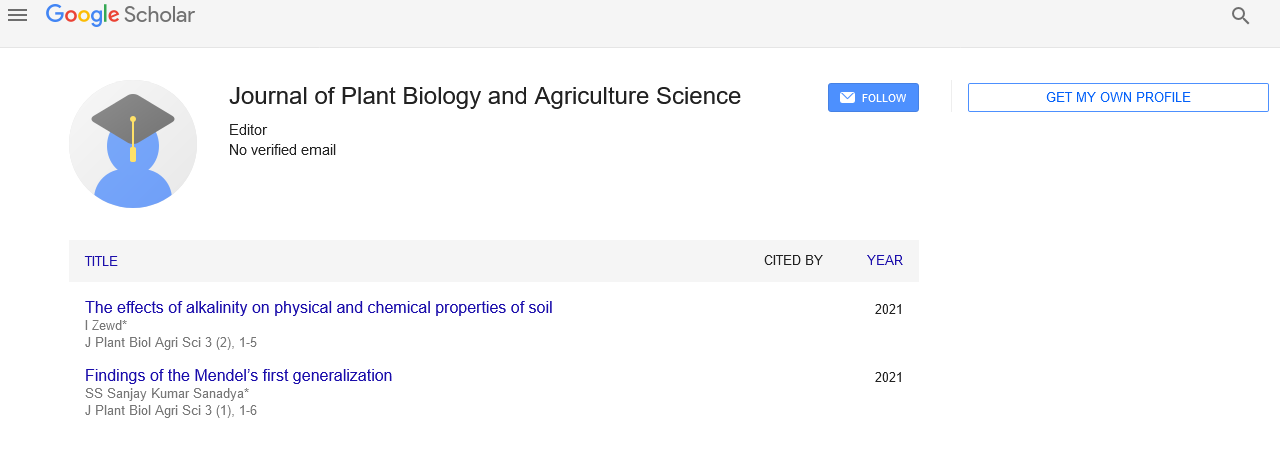Natural hybridization
Received: 27-Aug-2021 Accepted Date: Sep 10, 2021; Published: 17-Sep-2021
Citation: Christophe D. Natural hybridization. J Plant Biol Agri Sci . 2021;3(1):3.
This open-access article is distributed under the terms of the Creative Commons Attribution Non-Commercial License (CC BY-NC) (http://creativecommons.org/licenses/by-nc/4.0/), which permits reuse, distribution and reproduction of the article, provided that the original work is properly cited and the reuse is restricted to noncommercial purposes. For commercial reuse, contact reprints@pulsus.com
Description
Natural hybridization may be a significant evolutionary process that happens in some groups of plants and may end in progeny that are ready to exploit new habitats and possibly cause the formation of new species. The discovery of a natural hybrid generally arouses interest, although some observers take it to the acute and display more interest within the hybrid than within the parent species involved.
Interspecific hybrids: Interspecific hybrids are progeny resulting from the mating individuals of different species and intraspecific hybrids are hybrids from the mating of individuals within a species. They are basically completely or partially sterile.
Similar but different: hybrid progeny of comparable general appearance but of various genetic makeups may result from the natural crossing of related taxa.
Intergeneric Hybrids: An intergeneric hybrid may be a cross between plants in two different genera within the same family. They are enough closely related that pollination will produce a hybrid, though the seeds of these hybrids are sterile.
Factors Influencing Natural Hybridisation: Natural hybrids between native orchid species usually only occur when the oldsters grow in close proximity and their flowering times overlap. Both species must share a pollinating agent, albeit just for the brief period that pollen transfer occurs. The abundance of parent species at any location is directly proportional to the occurrence of natural hybridisation. Events triggering mass flowering, like summer bushfires or good seasonal rains also increase the probabilities of natural hybridisation.
Many orchid species have specific pollinating agents but sometimes environmental factors cause a breakdown of barriers that isolate them. Natural hybrids are more frequent in disturbed sites (cleared habitats, road verges, etc) than in natural environments, possibly thanks to the breakdown of isolating mechanisms or changes in foraging behaviour by pollinators.
Absence of Natural Hybrids: Many species don't hybridise despite growing sympatrically and with overlapping flowering times. Often this will flow from to strict pollinator isolation, as occurs in species pollinated by sexual deceit, but other factors can have an influence. For example Rhinerrhizopsis moorei and Pomatocalpa macphersonii share an equivalent pollinator, a native bee, within the Iron Range area of northern Queensland, but are isolated by the location of the pollinarium on the insect. When visting R.moorei the pollinarium is deposited on the top of the bee, whereas that of P.macphersonii becomes attached to the thorax. Similarly, but via a special route, all 5 native species of Cryptostylis are pollinated by an equivalent species of ichneumon wasp, Lissopimpla excelsa, but natural hybrids are unknown, despite it not being uncommon to seek out two or more species flowering sympatrically in eastern Australia. Artificial crossing tests are also failed to supply capsules indicating the presence of chemical or genetic barriers to hybridisation.
Persistence of Natural Hybrids: Some natural hybrids of terrestrial orchids aren't ready to reproduce and had limited life time, sometimes only persisting for two or 3 seasons. Others live longer period. By contrast, terrestrial hybrids which will reproduce vegetatively are ready to form clonal tufts or colonies and may persist for several years, a minimum of as long as suitable environmental conditions last. In epiphytic orchids, natural hybrids tend to be long-lived and should persist as individual plants for several years, usually without having the power to breed . Rarely local vegetative reproduction can occur by the assembly of aerial growths as in Vappaculum superbiens.
Successive Hybridisation: Many natural hybrids are sterile and are unable to take part in further hybridisation. Some hybrids however, are fertile and may produce second generation offspring or backcross to the oldsters. Complex hybridisation can produce a variety of variable hybrid offspring leading to hybrid swarms. This situation has been observed among Diuris pardina and D. chryseopsis in southern Victoria and various species of filamentous Jonesiopsis in Western Australia.





